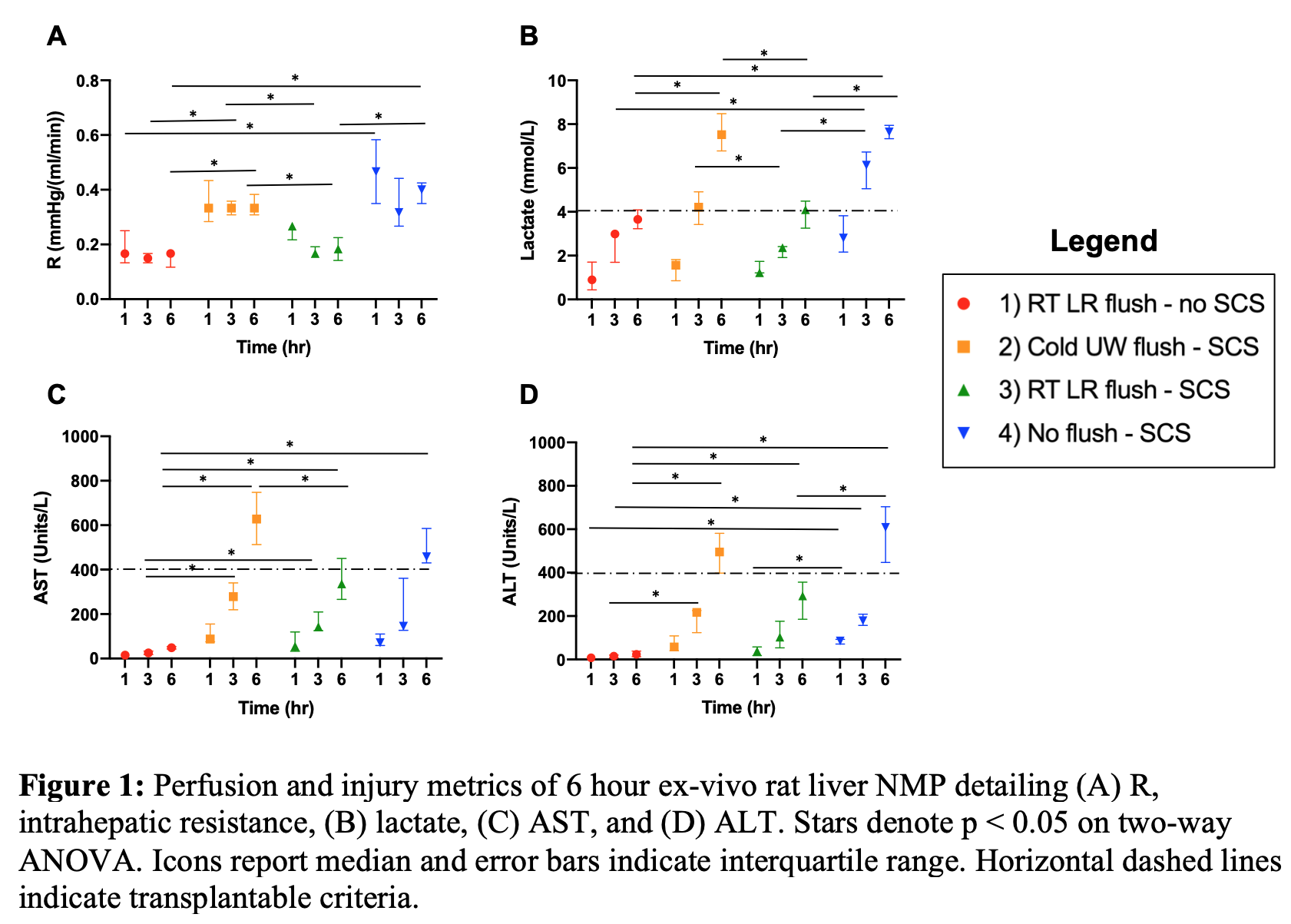The Harmful Effect of Retained Peripheral Cells During Flushing and Static Cold Storage in Rat Liver Normothermic Machine Perfusion
1Surgery, Beth Israel Deaconess Medical Center, Boston, MA, 2Massachusetts General Hospital, Boston, MA
Meeting: 2021 American Transplant Congress
Abstract number: 599
Keywords: Liver grafts, Liver preservation, Preservation, Preservation solutions
Topic: Basic Science » Ischemia Reperfusion & Organ Rehabilitation
Session Information
Session Name: Ischemia Reperfusion & Organ Rehabilitation
Session Type: Poster Abstract
Session Date & Time: None. Available on demand.
Location: Virtual
*Purpose: Retained donor blood in a liver graft can cause damage to resident cells that is exacerbated by static cold storage (SCS), leading to platelet activation, neutrophil extracellular trap formation, and RBC aggregation at reperfusion. We used normothermic machine perfusion (NMP) to study differences in hepatic function after a variety of flush and SCS conditions.
*Methods: Adult, Sprague Dawley rats were heparinized and the livers procured for 6 hours of NMP. Prior to NMP, livers underwent one of the following conditions (n = 4 per group): (1) room temperature (RT) lactated ringers (LR) flush with no SCS, (2) cold University of Wisconsin solution (UW) flush with 24h SCS, (3) RT LR flush with 24h SCS, or (4) no flush with 24h SCS. Perfusion metrics and injury markers were compared by two-way ANOVA testing and histology by H&E and TUNEL staining.
*Results: Comparing RT LR flush livers with 24h SCS versus no SCS yielded very similar perfusion results (fig 1). Since SCS had no effect on this model, we then compared livers with cold UW flush (group 2), LR flush (group 3), and no flush (group 4), and found, as expected, no flush livers had the highest resistance, lactate, and transaminase levels (fig 1). Interestingly, when we compared cold UW flush with RT LR flush, liver allografts flushed with RT LR had lower intrahepatic resistance (0.342 vs. 0.183 mmHg/ml/min, p = 0.007), lactate (7.59 vs. 3.94 mmol/L, p = 0.003), AST (629 vs. 351 U/l, p = 0.046), and ALT (491 vs. 278 U/l, p = 0.068) at 6 hours (fig 1). Histology also showed that compared to the cold UW flush livers, the RT LR flush livers had healthier cellular architecture, less endothelial damage, and less TUNEL staining.
*Conclusions: Cold UW appears to perform worse than RT LR as a flush, indicating that RT flush prior to cooling may have benefit. Clinically in humans, this would require a cold flush after a RT flush, as rat livers cool quickly on ice by virtue of being small. Conventional wisdom suggests that the cold flush should be UW rather than LR because of its preservation properties, but our results suggest that the quality of the flush is more important than the preservation properties. Further studies are needed to compare RT UW to RT LR and cold LR to cold UW flushes to ascertain whether it is UW solution or flush temperature that is damaging the liver allograft.
To cite this abstract in AMA style:
Haque O, Pendexter CA, Markmann JF, Uygun K, Yeh H, Tessier SN. The Harmful Effect of Retained Peripheral Cells During Flushing and Static Cold Storage in Rat Liver Normothermic Machine Perfusion [abstract]. Am J Transplant. 2021; 21 (suppl 3). https://atcmeetingabstracts.com/abstract/the-harmful-effect-of-retained-peripheral-cells-during-flushing-and-static-cold-storage-in-rat-liver-normothermic-machine-perfusion/. Accessed December 19, 2025.« Back to 2021 American Transplant Congress

